The only lamb recipes you will ever need for a big Easter feast...
Whether you prefer low and slow, traditional fare or something completely off-menu for your Easter lunch, these dishes are top of the chops

Apart from copious amounts of chocolate eggs, few things are more synonymous with Easter than a hearty lamb dish put out on the table for everyone to tuck into.
Although the traditional roast has reigned supreme for centuries of Easter celebrations, there are so many ways to serve up lamb that isn’t just low and slow (although we’ve still got you covered in that area).
Instead of buying a ton of rosemary, try other herbs and aromatics to complement the lamb. Or try one particularly delicious recipe from chef patron of Frenchie, Greg Marchand.
So whether you’re looking for something simple or are determined to serve up a show-stopping feast this Easter, our pick of the best lamb recipes includes something perfect for everyone.
Roast lamb with garden veg, oregano and feta
From wildlife and nature presenter to amateur chef with her own cookbook, Kate Humble’s recipes are based on eating seasonal ingredients. This is a dish to enjoy all year round – be sure to load up on vegetables...
Serves: 6
Ingredients:
For the lamb:
1 leg of lamb, about 2kg
2 garlic cloves, sliced
Olive oil
A handful of rosemary and thyme sprigs
A generous glass of red wine
For the vegetables:
400g broad beans in their pods, or 200g frozen broad beans
300g French beans
100g peas (fresh or frozen)
Leaves from 3 sprigs of oregano
Zest of 1 lemon, juice of half
Olive oil
50g feta
Salt and pepper
Method:
1. Preheat the oven to 200C (400F), gas mark 6. Make sure your lamb is at room temperature before you cook it, so take it out of the fridge at least 20 minutes beforehand. With a knife, make small, deep cuts all over the leg of lamb and push a slice of garlic into each one. Rub over some olive oil and season well with salt and pepper.
2. Put the rosemary and thyme sprigs in the bottom of a roasting tin and place the lamb on top. Put in the oven and cook for about one hour and 10 minutes if you want your lamb to be pink (it’s so much tastier when it is) or for longer if you want it cooked through. Remove from the oven, put the lamb on a board and let it rest for 10 minutes or so before you carve it.
3. Remove the rosemary and thyme sprigs from the tin, then put the tin over a high heat on the hob. Add the wine to the juices and let it bubble for a moment or two to form a thin but tasty gravy. Pour into a jug and keep warm.
4. Cook the broad beans (shelled, if fresh) in boiling water for about two minutes. Drain and tip them into a bowl of cold water. Slip off the skins to reveal the bright emerald green beneath. This is, I admit, a bit of a faff, and you don’t have to do it, but they taste so, so much better without the skins. Set aside. Cook the peas briefly in boiling water, drain and set aside. Trim the tails off the French beans and steam or plunge into boiling water and cook until they’re al dente. Drain and put in a bowl together with the broad beans and the peas.
5. Finely chop the oregano leaves and add all but a few (saved for garnish) to the vegetables. Add the lemon zest and then drizzle over a bit of olive oil to make the vegetables glossy, but not swimming in it. Squeeze over the lemon juice, season with salt and pepper and mix gently. Tip into a pretty serving bowl, crumble over the feta and scatter with the remaining oregano leaves. Carve the lamb, pour the gravy over the slices and serve the vegetables alongside.
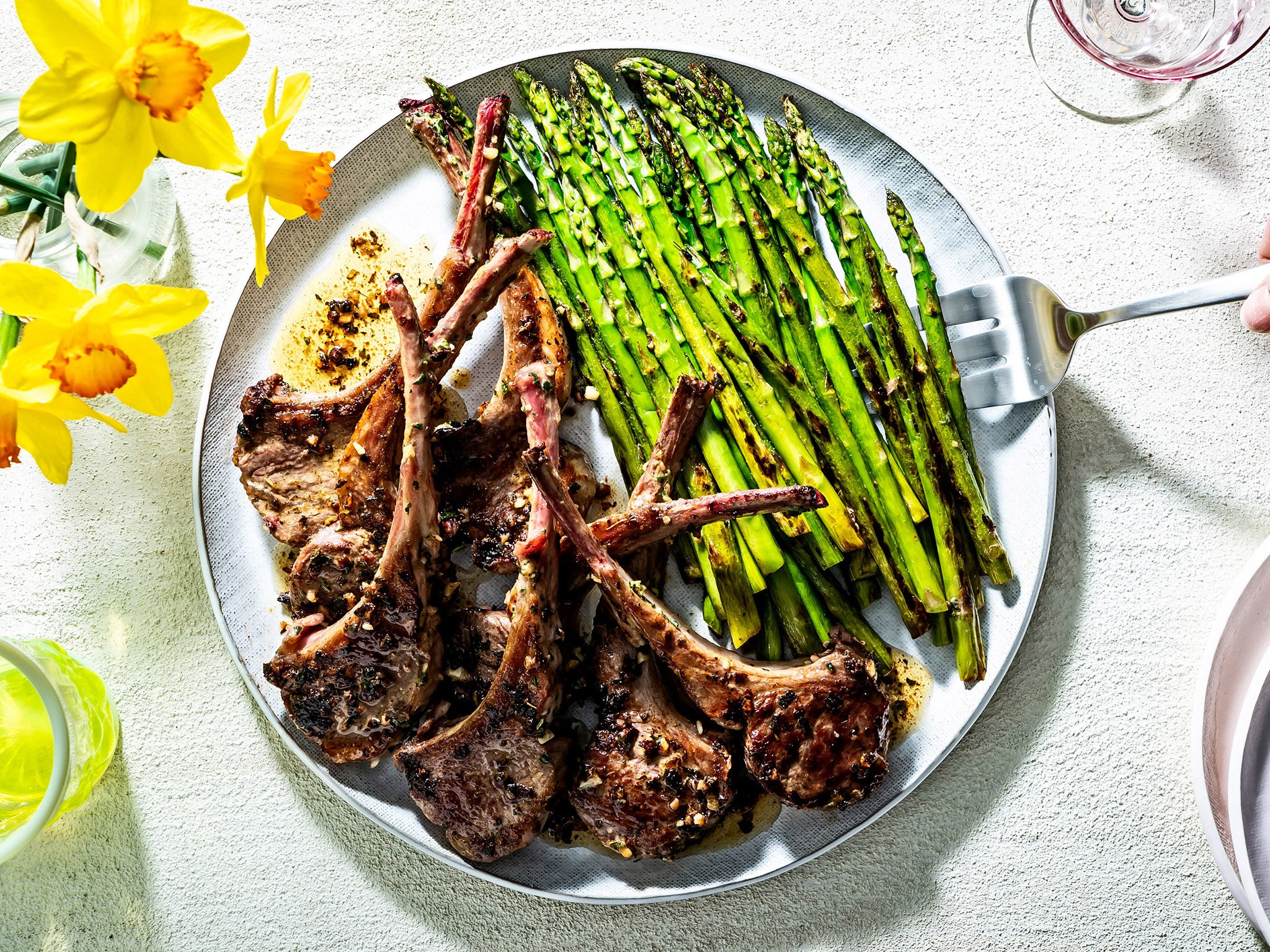
Butter-basted lamb chops
These butter-basted lamb chops from recipe developer Alexis deBoschnek’s first cookbookTo the Last Bite are just right any time you’re in the mood for a celebratory spring meal.
If lamb is your traditional Easter centrepiece, consider this as an option, especially if time is tight – it comes together in about 40 minutes – or you’re feeding a smaller crowd.
Serves: 4
Time: 40 minutes
Fresh herbs – use the ones suggested here or your favourites – garlic, mustard and creamy butter impart big flavour to lamb chops. If you’re short on time, marinate the chops for just 10 minutes on the counter while you pan-fry asparagus or make a green salad to go on the side. You also may marinate chops for up to 2 hours in the fridge, if desired. “Any longer and you run the risk of the acid in the marinade breaking down the proteins in the meat, resulting in a gray, mushy chop,” DeBoschnek says. If you prefer lamb on the rare side, reduce the cooking time. We added asparagus for a springtime supper.
Storage notes: Refrigerate for up to 3 days.
Ingredients:
15g finely chopped fresh sage
7g fresh thyme leaves, plus more for serving
4 garlic cloves, minced or grated
5 tbsp olive oil, divided
1 tbsp Dijon mustard
1 tsp fine salt, plus more as needed
1 tsp freshly ground black pepper, plus more as needed
680g lamb rib chops (about 8 chops)
1 bunch asparagus (about 450g total), woody ends trimmed and cut in half
¼ cup (60ml) chicken stock or water
1 tbsp unsalted butter
Method:
1. In a large bowl, stir together the sage, thyme, garlic, 3 tablespoons of the olive oil, the Dijon mustard, salt and pepper. Add the chops and, using your hands, evenly coat them with the herb mixture. Cover the bowl and let marinate for at least 10 minutes on the counter, or cover and refrigerate for no more than 2 hours (if refrigerating, let the chops rest at room temperature for at least 10 minutes before cooking).
2. While the chops are marinating, in a large frying pan with a lid over high heat, heat 1 tablespoon of the olive oil until shimmering. Add the asparagus and cook, stirring frequently, until they start to brown and blister, about 5 minutes. Pour in the stock or water, reduce the heat to low, cover and steam for 1 minute. Remove the pan from the heat, but keep covered.
3. Set two plates next to the stove.
4. In a large frying pan over high heat, heat the remaining 1 tablespoon of olive oil until shimmering. Working in batches so as not to crowd the pan, add half of the lamb chops and cook, without moving them, until golden brown on one side, about 3 minutes, depending on how rare you like lamb. For medium, you want an instant-read thermometer to register 55C. Flip the chops, add ½ tablespoon of butter to the pan, and continue cooking until golden brown on the other side, an additional 2 to 3 minutes, adjusting the heat as needed. As the butter melts, spoon it over the lamb chops.
5. Transfer the cooked chops to one of the plates and cover with the other plate. Repeat with the remaining chops and butter. When finished, spoon any remaining pan juices over the chops.
6. Chops may be of different thickness, so check them toward the end of cooking time, and remove them as they reach desired level of doneness. The butter will brown, but if the butter, garlic or herbs burn, carefully wipe out the pan and add fresh oil and butter before cooking the second batch.
7. Serve the chops and asparagus warm or at room temperature, sprinkled with more fresh thyme – if desired.
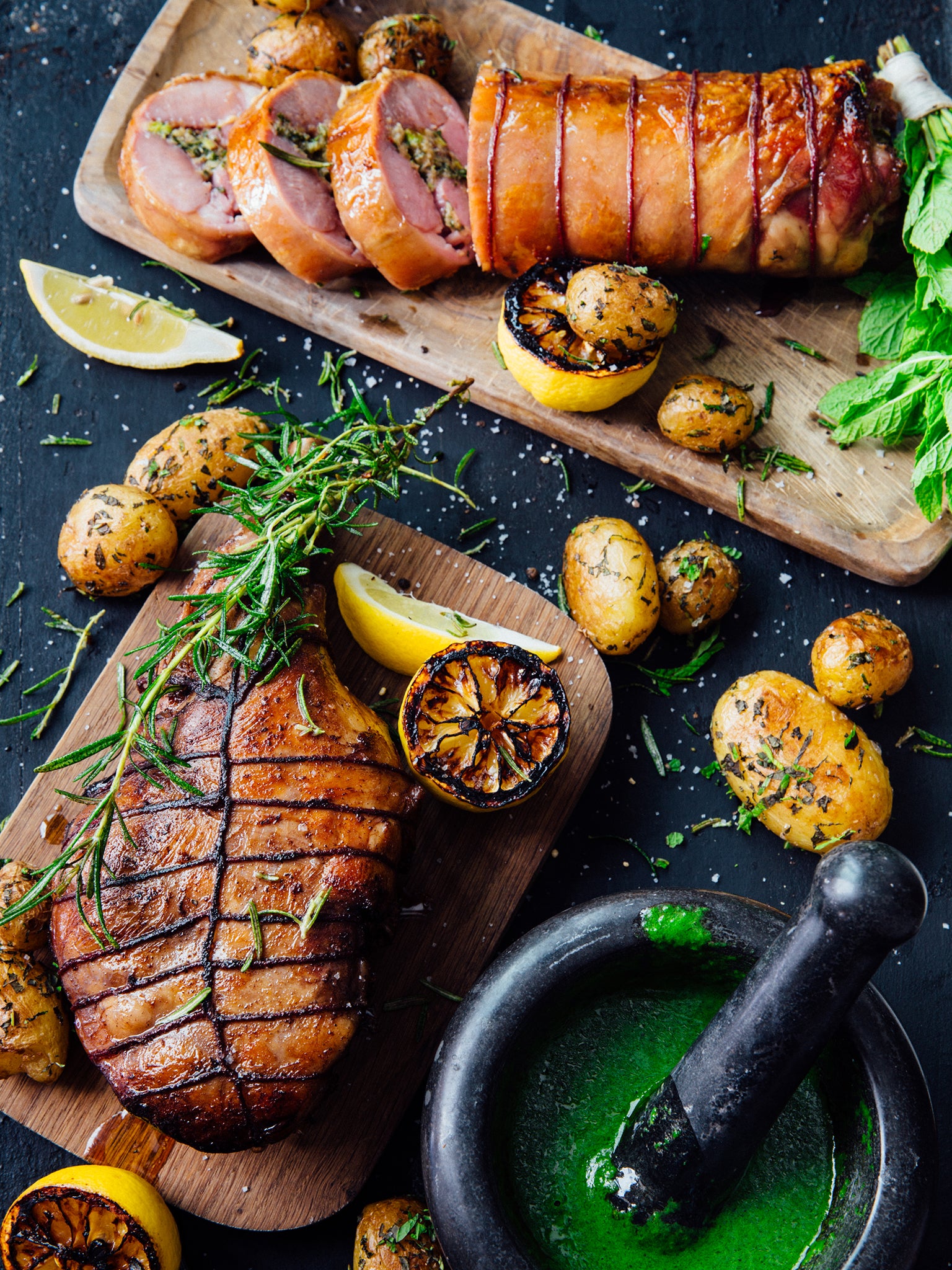
Stuffed leg of lamb with Jersey Royal potatoes
This recipe from Greg Marchand, chef patron at Frenchie, is a delicious twist on a classic lamb roast that won’t take hours to prepare. Complete your masterpiece with buttery potatoes and you’ll have an Easter dish you’ll remember for years to come.
Serves: 4
Preparation: 1 hour 30 minutes
Ingredients:
For the stuffing:
2 shallots, finely sliced
50ml water
50ml white wine vinegar
1 tsp sugar
200g mint, blanched and coarsely chopped
200g sandwich bread, toasted and cooled
45g pistachio nuts, roasted and coarsely chopped
40g parmesan cheese
3 anchovies
Dash of Tabasco sauce
2 eggs
½ tsp thyme
For the lamb:
1 leg of lamb, deboned, you can ask your butcher to remove the bone
For the Jersey Royal Potatoes:
600g Jersey Royal potatoes
200g butter
½ bunch mint, minced
Juice of 1 lemon
Pinch of salt
Method:
1. For the stuffing, combine all ingredients and cook over medium heat until the liquid evaporates and the shallots are translucent. The mixture should be moist and should hold its shape if rolled into a ball.
2. For the lamb, preheat the oven to 220C (gas mark 7).
3. Stuff the leg and tie it up. Heat the oil in a skillet or frying pan and brown the meat well on all sides. Roast the leg with 3 lemons, halved, for 30 minutes, and then reduce the temperature to 180C (gas mark 4) and cook for a further hour.
4. Take the meat out of the oven, wrap in aluminium foil, and rest for 20 minutes.
5. For the potatoes, in a stockpot, cover the potatoes with cold water and add plenty of salt. Bring to a boil and cook the potatoes until they are soft, about 20 minutes, then drain.
6. Heat the butter in a large skillet or frying pan and brown the potatoes over low heat. Add the mint and season with lemon juice and salt.
7. Serve the potatoes in a side dish. Carve the lamb at the table and serve with the roasted lemons.
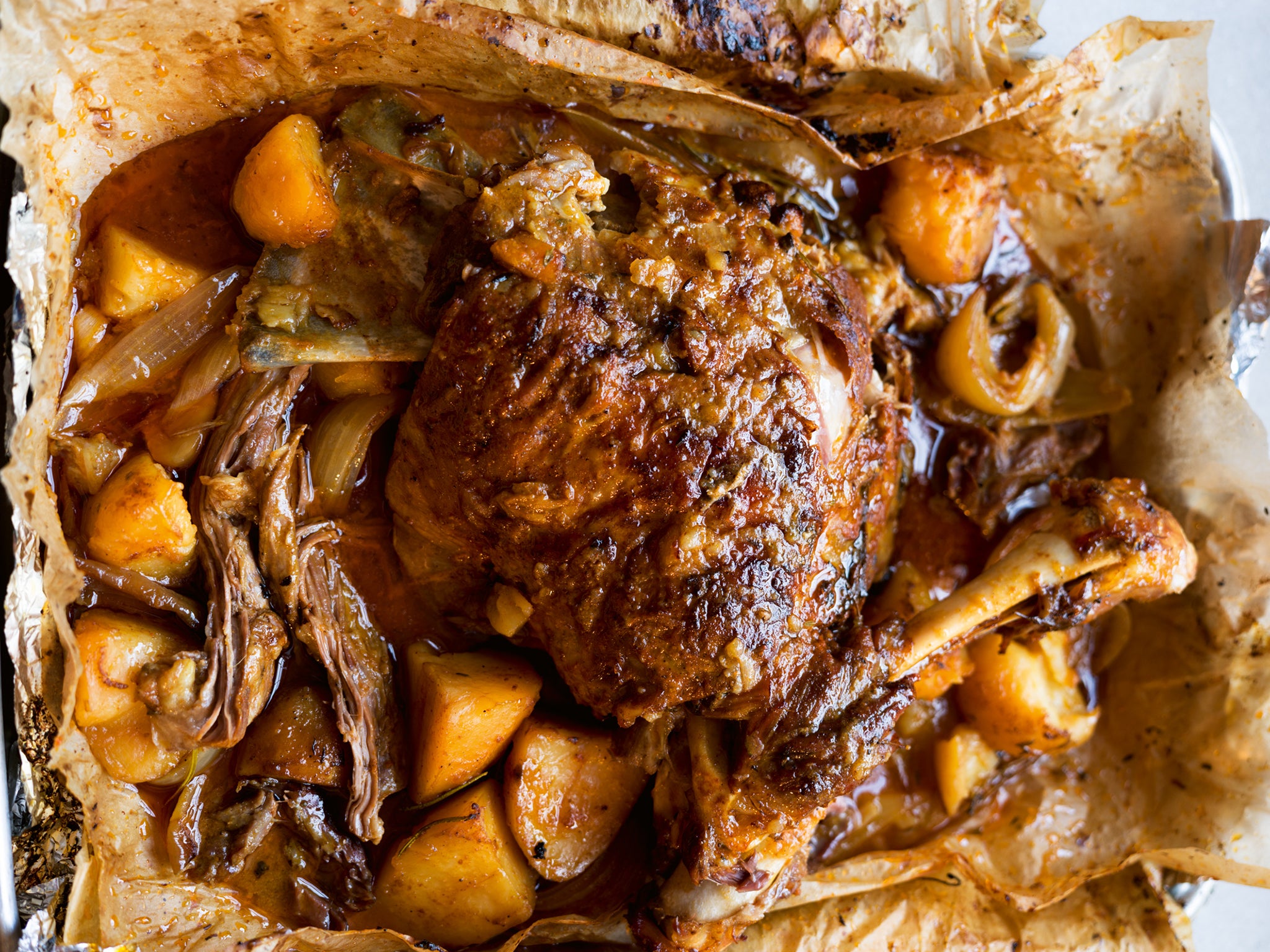
Kataf ghanam (lamb shoulder)
Take inspiration from traditional Syrian cuisine for your Easter feast with this recipe from Imad Alarnab.
Serves: 4-6
Ingredients:
For the marinade:
5 garlic cloves, grated
2 tbsp smoked paprika
1 tbsp mild Madras curry powder
½ tbsp ground black pepper
3cm piece of fresh ginger, grated
1 tbsp baharat (a spice mix blend)
Juice of 1 lemon
1 tbsp tomato puree
2 tbsp red pepper paste
Good pinch of salt
150ml olive oil
For the lamb:
1.5-2kg lamb shoulder, bone in
10 garlic cloves, peeled
4 sprigs of thyme
4 sprigs of rosemary
Method:
1. Mix together all the marinade ingredients in a large container. Rub the marinade all over the lamb so it’s completely covered. Cover and marinate in the fridge for a minimum of 4 hours, ideally overnight.
2. When you’re ready to cook, preheat the oven to 160C/fan 140C/ gas mark 3.
3. Take the lamb from the fridge, then get a high-sided oven tray and line with a layer of foil and a layer of baking paper, large enough to cover the lamb. Add the garlic and herb sprigs to the middle, followed by the lamb and all the marinade (you can also add onions, carrots or potatoes at this stage, if you like). Fold the foil and baking paper over the lamb like a parcel, then flip it over and wrap it again in another layer of foil so the lamb is tightly wrapped and there are no gaps. We want to cook the lamb in its own juices, so it’s really important that it’s completely covered at this stage.
4. Place in the oven and cook for 4 hours or until the meat is falling off the bone. Remove from the oven, unwrap, increase the temperature to 200C/fan 180C/gas mark 6 and roast until browned on top.
5. Serve with kabsa rice or plain bulgur.
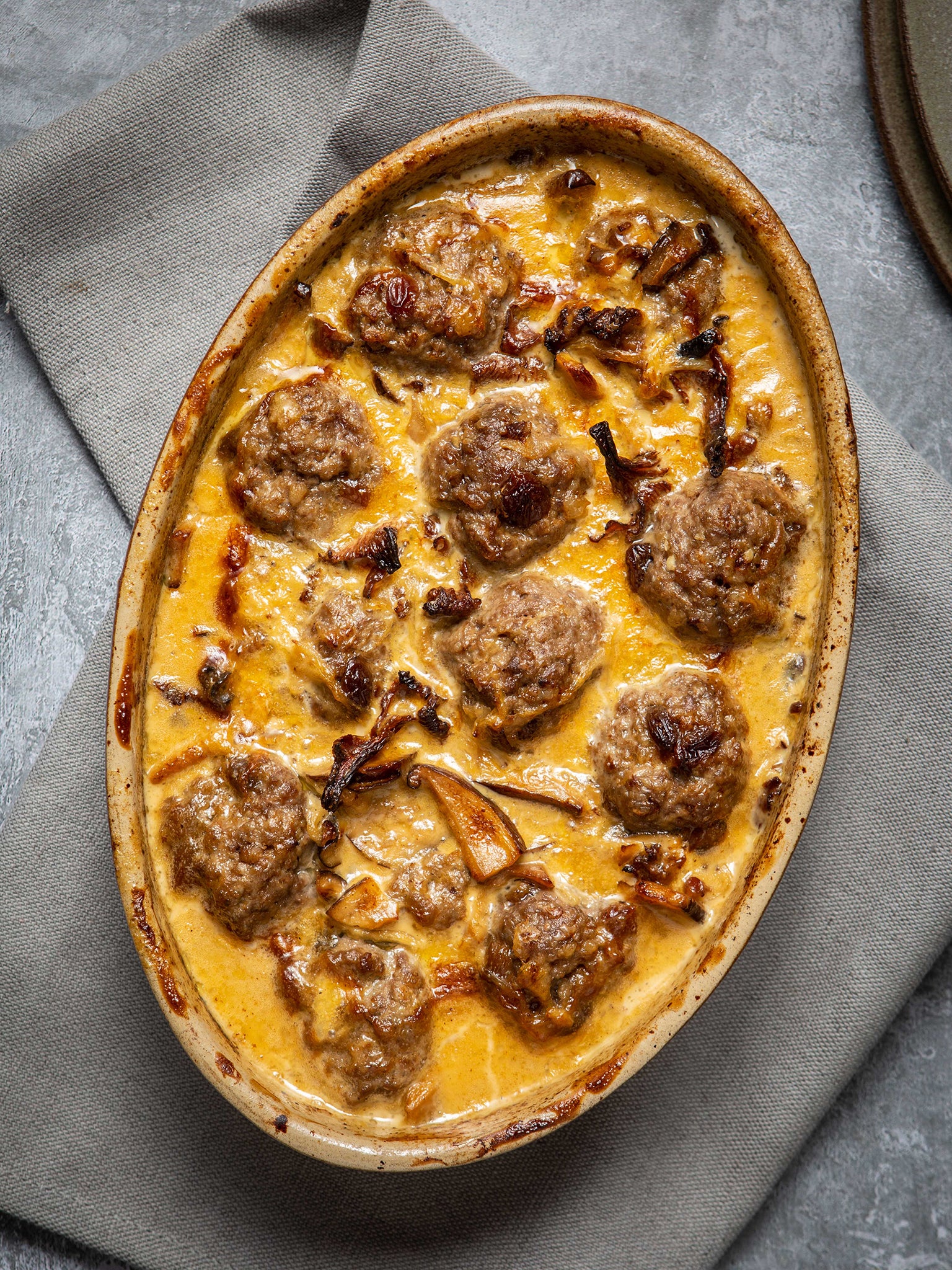
Roast hogget meatballs in a creamy cep sauce
Ever thought of turning your lamb into meatballs? Well, with this dish from The Black Swan’s Tommy Banks, you can!
Serves: 4-6
Prep time: 15-20 minutes | Cook time: 55 minutes
For the meatballs:
600g minced hogget (or lamb)
60g dried prunes
40g breadcrumbs
½ medium onion, chopped
1 tbsp crushed garlic
1 tsp black pepper
1 tsp salt
1 tsp mace (optional)
For the sauce:
1 large onion, sliced
200g cep mushrooms, cut in half
100ml medium sweet white wine
200ml lamb stock
500ml double cream
2 cloves garlic, crushed
1 tsp cep powder (optional)
1 bouquet garni
Method:
1. Preheat oven to 200C (180C Fan). Then, in a large mixing bowl, combine all meatball ingredients. Using your hands mix all the ingredients together really well, squeezing and mashing the mince so everything is nicely combined.
2. Roughly divide the mixture into around 16-18 golf ball-sized balls.
3. In a medium pan over medium heat, add your meatballs, in batches if needed, and brown until golden, about 6 to 8 minutes. Set aside. In the same pan, add 1 tablespoon sunflower oil. Add your onions, garlic and mushrooms and allow to sweat down, about five minutes.
4. Continue cooking until ingredients begin to caramelise, a further three minutes, then add your white wine. Allow the wine to bubble and reduce for about two minutes. Add lamb stock and allow it to reduce, for a further five minutes. Add your cream, and cep powder if using, and stir vigorously to fully incorporate. Remove from heat.
5. In an ovenproof baking dish, add your meatballs and cover with your cream sauce. Bake in the oven for 30 minutes.
6. Serve with fresh, toasted sourdough.
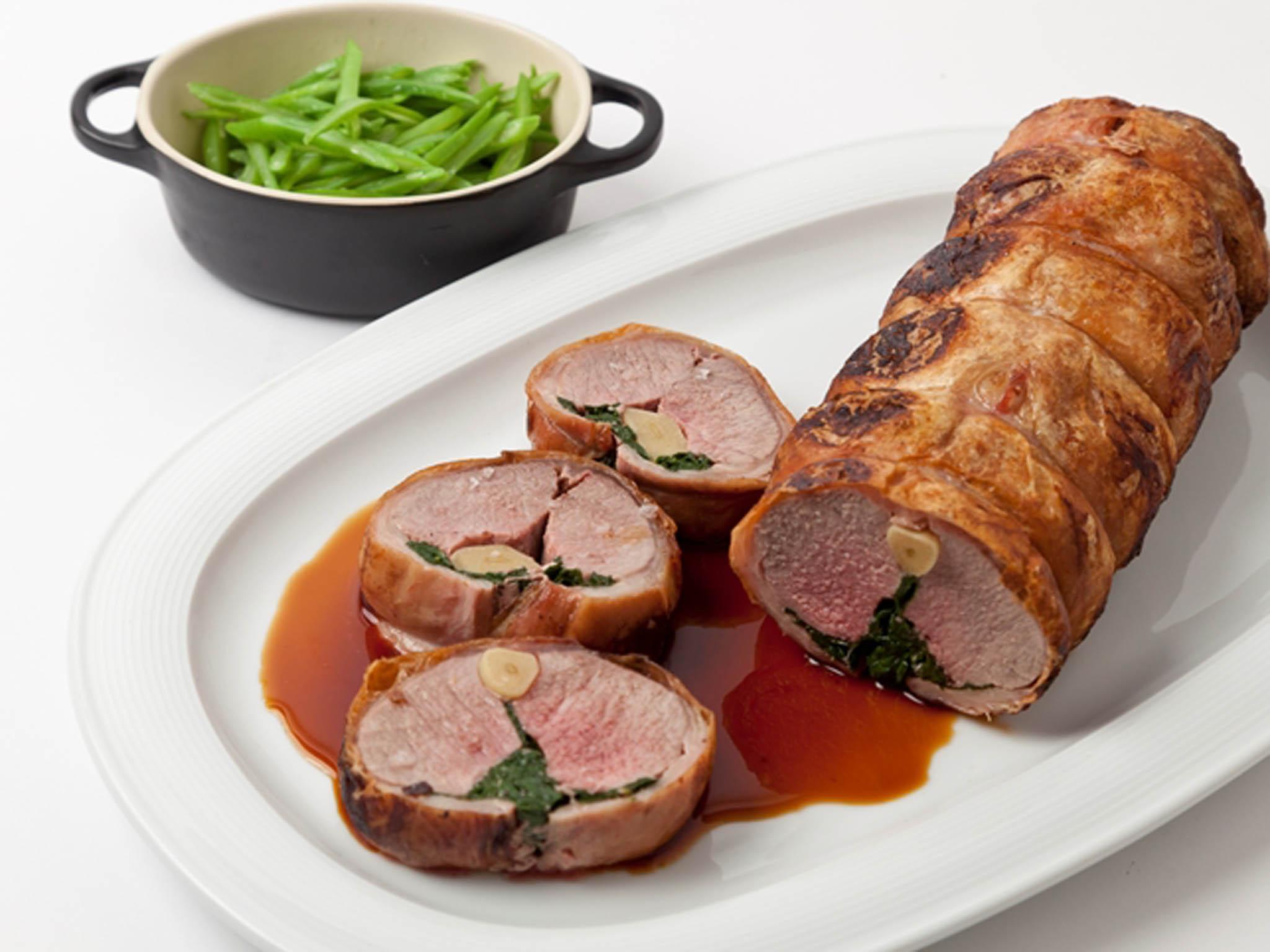
Stuffed saddle of Lune Valley lamb with buttered runner beans
If you are committed to cooking your lamb low and slow, this recipe from Adam Gray will be sure to stir up an appetite.
Time: 3 hours
Serves 4
Roast lamb saddle
1 small boned saddle of Lune Valley lamb, retaining bones for gravy
10 garlic cloves, peeled
500ml of rapeseed oil
500ml of lamb stock
1 sprig of rosemary
500g of baby spinach
Salt
White pepper
To serve
200g of runner beans
75g of unsalted butter
4 large potatoes, cut into 8 cm discs
200ml of rapeseed oil
75ml of water
1. Start by making the gravy. Preheat the oven 180C. Chop the bones from the lamb saddle into evenly sized pieces and place in a roasting tray in the oven. Cook until evenly golden brown. This will take over an hour. Meanwhile, gently heat enough rapeseed oil in a pan to cover the whole garlic cloves, add the garlic and let it simmer for 40 minutes to 1 hour until the garlic is soft. Strain off the oil and set aside.
2. When the lamb bones are evenly browned, remove from the oven and transfer to a saucepan. Cover with the lamb stock and rosemary sprig, bring to the boil and simmer gently for 20 to 30 minutes. Pass the lamb gravy through a fine sieve. Reheat when ready to serve.
3. To stuff the lamb, lay the boneless saddle flat on a chopping board, so the two portions of meat are facing away from you. Season liberally with salt and pepper. Place the cooked, drained garlic cloves lengthways along the centre of the saddle.
4. Blanch and refresh the spinach, then squeeze out any excess water. Lay the spinach over the garlic cloves, along the centre of the lamb saddle. Fold the lamb saddle over so the flaps of fat overlap each other. Tie the saddle tightly with butcher’s string in 2 to 3 cm intervals along the whole saddle and leave to rest in the fridge for 30 minutes.
5. Preheat the oven to 200C. Heat an ovenproof frying pan to a medium heat and place the lamb saddle in without any oil. Seal the lamb saddle all over until light golden brown, then place the pan in the oven. After 5 minutes turn the oven down to 180C and continue cooking for a further 15 to 20 minutes for medium rare cooking or more if you like it well done. Remove the cooked lamb saddle from the oven and leave to rest on a wire rack for 10 minutes.
6. Next, cook the potatoes by placing in salted cold water, bring to the boil and simmer until almost tender. Drain and set aside. To prepare the runner beans, slice them on an angle and blanch in boiling salted water until tender. Strain and place into iced water immediately.
7. Return the cooked lamb saddle to the oven for 3 to 4 minutes to reheat, then remove. While the lamb is heating through, pan-fry the cooked potato discs in a little rapeseed oil until golden brown on both sides. Season with salt and pepper. Place the golden brown potato discs in the centre of the serving bowls.
8. In a separate saucepan melt the unsalted butter with 75ml water and bring to the boil, then add the runner beans. Coat the runner beans with the butter and water emulsion, then season with salt and pepper. Keep warm. Cut all the string from the lamb saddle and then carve the saddle into 1.5 cm slices and arrange on top of the potato discs. Put the buttered runner beans in a separate serving dish and pour the lamb gravy into a jug. Serve immediately.
Slow-roasted harissa lamb shoulder

TikTok-famous chef chef Poppy O’Toole described her mouth-watering dish as “a slow-roasted number that will turn even hardened lamb-haters”. If that doesn’t convince you, we don’t know what will...
Serves: 4-6
Ingredients:
The core:
2 recipe quantities of easy flatbreads (8 flat breads; see below)
For the lamb:
2tbsp rose harissa paste
3tbsp ras el hanout
Zest and juice of 1 lemon
5 garlic cloves, peeled
1tbsp light brown soft sugar
6 thyme sprigs, leaves picked
6 rosemary sprigs, leaves picked
2tbsp almond butter
2tbsp olive oil
1.4-1.5kg/3-3 ¼lb lamb shoulder on the bone
For the couscous:
200g/7oz couscous
Seeds of 1 pomegranate
A small bunch of mint, leaves picked and chopped
A small bunch of flat-leaf parsley, leaves picked and chopped
5-6 black or green olives, pitted and sliced
1tbsp dried oregano
Juice of 1 lemon
Salt and black pepper
For the flatbreads (makes 4):
250g/9oz plain flour, plus extra for dusting
250g/9oz Greek yogurt (or 125ml/½ cup warm water + 2tbsp vegetable oil, if you’re vegan)
1tsp onion seeds, poppy seeds or sesame seeds
1tsp baking powder
Salt and black pepper
Method:
1. Start this the night before you want to cook. Place all of the lamb ingredients apart from the meat itself into a blender and blitz to a smooth paste to make a marinade.
2. With a knife, make some little incisions into the lamb shoulder to help the marinade get right into the meat. Rub and massage the marinade into the shoulder like it’s date night, until it’s completely covered.
3. Transfer the lamb to a roasting tin, cover with foil and place it in the fridge overnight (or for a minimum of six hours).
4. Make the flatbreads: in a bowl mix all the ingredients – flour, yogurt, seeds, baking powder and seasoning – into a dough. Knead for about three minutes, to a soft but not sticky ball. Cover with a clean tea towel and leave for 10 minutes to rest.
5. Cut the ball into four equal pieces and use a rolling pin to roll each one out to a thin round. You’re aiming for them to be about 12cm/5in diameter – but don’t worry if they look rustic in shape. Set aside the rolled-flat flatbreads on a lightly floured surface.
6. Place a large, dry frying pan over a high heat. Leave it to get hot, then throw in the first flatbread – no oil, no butter, nothing… just dry, hot heat. Once bubbles start to form in the dough (about 30 seconds) and you’ve got a little bit of char on the underside, flip over the flatbread and cook the other side for about 30 seconds, to get a little bit of char there, too. Keep warm while you do the same with the remaining three flatbreads. That’s it, remove from the pan and either serve right away or cool and tightly wrap to store.
7. Put the couscous into a container big enough to allow it to double in size and pour in 400ml/about 1½ cups of cold water. Cover the bowl and transfer it to the fridge. Leave this overnight, too.
8. Remove the meat from the fridge 30 minutes before you intend to start cooking so that it can come up to room temperature, and preheat the oven to 190C/170C fan/375F/gas 5.
9. When you’re ready to cook, roast the lamb, still covered with the foil, for 4 hours, until it is charred a little on the outside and the meat is tender and pulls apart.
10. Drain the couscous through a fine sieve, so you don’t lose any of it. Mix all of the other couscous ingredients into it. Season with salt and pepper to taste and leave on the side to come up to room temperature.
11. Towards the end of the lamb cooking time, heat a dry frying pan over a high heat until it’s smoking hot. Place the flatbreads in the pan and warm through (or reheat them in a microwave).
12. Either serve your massive hunk of delicious lamb in the tin as it comes, or transfer it to a wooden board and pour all of the sauce that is left in the bottom of the roasting tin into a little jug.
13. Just let people dig and tear into this huge, sharing-lamb deliciousness, with the warmed flatbreads, the couscous and the sauce served alongside.





Join our commenting forum
Join thought-provoking conversations, follow other Independent readers and see their replies
Comments